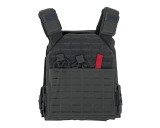Bulletproof backpacks: What you need to know - Battle Steel®️
Bulletproof backpacks: What you need to know
As incidences of mass shootings and school shootings are becoming all the more common, sales of bulletproof backpacks are steadily increasing. Many companies which began by selling armoured products to police and military only are now seeing greater demand from members of the public in the days following shootings, especially those which take place in schools. This is unfortunately the world we live in, where not only military and law enforcement personnel must protect themselves against serious ballistic threats, but civilians must, too. Just like it is a reasonable precaution to own a fire extinguisher in case of fire, or a motorcycle helmet in case of a road collision, many people want to be prepared for the worst-case active-shooter scenario. Owning a bulletproof backpack is one way to do this, and knowing that your loved ones have some form of protection can provide peace of mind for many people.
What is a bulletproof backpack?
Ok, technically, you would better say “ballistic backpack” or “bullet-resistant backpack”. These terms are more professional and better describe the nature of protection such backpacks provide. However, the term “bulletproof backpack” is so wide-spread today, so for the sake of clarity we will use the bulletproof backpack wording too. Simply keep in mind that the backpacks we discuss here are not truly bulletproof as this name would suggest. They are bullet-resistant.
Bulletproof backpacks are designed to protect the wearer with panels of bullet-resistant materials. These panels are made from multiple layers of extremely strong material, which dissipate most of the energy from a high-velocity projectile. As bulletproof backpacks are intended to be worn on a daily basis, they are typically reasonably priced, discreet and lightweight, making them suitable for:
- Students or staff at schools and universities
- People who work in or frequently travel through an area with high levels of crime
- Military or law enforcement personnel
There are two types of product available to prospective buyers:
- A bulletproof backpack where the panel is incorporated into the bag’s structure.
- A plate-carrier backpack where the protective panel can be inserted and removed.
What are bulletproof backpacks made from?
There are two types of plates used in bulletproof backpacks – hard and soft – and each can be made of different materials.
Soft plates
- Kevlar: made from a heat-resistant fibre called Aramid which is five times stronger than steel, and is densely woven and layered into a panel.
- Twaron: a fibre similar to Aramid which is lightweight, heat-resistant and very durable.
- Dyneema: a type of ultra-high molecular weight polyethylene which is fifteen times stronger than steel.
- Gold Shield: commonly used in plate-carrier backpacks and made from an Aramid-based material.
- Spectra Shield: a high molecular weight polyethylene which is another popular material for bulletproof backpacks.
Hard plates
- Commercial ballistic steel: a form of steel which has been specially manufactured for use in body armour. It has different levels of hardness, and Level III plates are usually medium-level.
- Composite ceramic: these plates comprise layers of different materials, including Kevlar. Ceramic plates are harder than a bullet, slowing it down and breaking it when hit.
Protection provided by bulletproof backpacks
As with other kinds of body armour and shields, the bullet-resistant armoured plates used to fortify these backpacks are tested by the National Institute of Justice (NIJ) in accredited ballistics labs. Please note that only the plates are tested and certified, not the backpacks themselves. The NIJ ranks body armour in several classifications according to the threat-specific protection that it provides. Below we have provided a basic outline of the different NIJ classifications (read our other article about how to choose the right body armour for more detailed information).
Soft plates
Level II: can withstand .9mm bullets and .357 Magnum bullets. Panels of this kind are suitable for full-time daily use.
Level IIIA: also provides protection against most handguns, high-velocity .9mm bullets and .44 Magnum bullets. These panels are usually suitable for everyday wear. They are typically soft but can also be hard plates.
Hard plates
- Level III: all of the above, plus protection against 7.62mm FMJ rifles. However, these plates do not offer protection against certain 5.56mm calibre bullets.
- Level IV: can withstand a single shot from Levels II-III, as well as .30 calibre armour piercing rifles.
Most commonly, bulletproof backpacks for civilian use are of the Level IIIA classification. This is the highest possible level for soft armoured plates, which are light, flexible and inconspicuous enough to be carried on a daily basis, while providing protection from short and long-barrelled handguns.
Level IIIA bulletproof backpacks do not provide protection against AR-15s and other assault rifles. A backpack would require a Level III or IV hard metal or ceramic panel in order to withstand fire from this kind of weapon. They are also not designed to protect the wearer from a high number of shots or from stabbings (stab-proof and bulletproof vests are rated as ‘multi-threat armour’).
People who are concerned for their safety might want to go all out and purchase Level III or IV body armour. However, this may be counterintuitive. These hard-armour plates are much heavier, and designed for wear by the police and military in tactical situations where a high level of protection is needed. They are unsuitable for everyday civilian use and will hinder the movements of those who wear them. When purchasing a bulletproof backpack, especially for a child, make sure that you know the full weight of the backpack + plate insert beforehand, and that it is appropriate for them to carry every day.
Bulletproof or bullet-resistant?
Although the phrase ‘bulletproof backpack’ is most commonly used, it would be more accurate to describe them as ‘bullet resistant’. No piece of armour is truly bulletproof and it is important to be realistic and manage your expectations. Bullet-resistant panels are certified in test conditions, from certain distances and against a certain calibre of weapon and ammunition. But active-shooter situations are not test conditions and a bulletproof backpack does not equate to a forcefield. As we have emphasised, protection depends on the type of ammunition and weapon used. In a case when the backpack does come between a bullet and the wearer, the backpack will resist the bullet’s penetration but the wearer may still be injured by the force of the impact.
However, any protection is better than no protection at all. When used correctly, bulletproof backpacks give the wearer a significantly higher chance of survival against certain ballistic threats. In an active-shooter situation, the wearer should make themselves as small as possible and shield themselves behind the armoured panel in the backpack. When standing or running, the wearer should take extra care to shield the head and torso – either by holding the backpack in front of or behind their head.
Recent Posts
-
Understanding Ballistic Shield Ratings and Their Applications
The Trusted Name in Tactical Defense - BattleSteel® When it comes to protecting those who protect us …2025-04-19 -
The Importance of Hearing Protection in Tactical Environments
The Legacy of BattleSteel® BattleSteel® is a trusted name in the world of tactical defense equipment …2025-04-14 -
How to Properly Fit and Wear a Plate Carrier
About BattleSteel and Their Mission BattleSteel is a trusted name in the tactical gear industry, ren …2025-04-11


